Choosing the wrong cookware manufacturer can cost you thousands in defective products, delayed shipments, and lost customer trust. After 27 years in this industry, I've seen importers make costly mistakes.
Before placing your next cookware order, ask these 10 critical questions to ensure you partner with a reliable manufacturer who can deliver quality products on time and within budget.

These questions will help you avoid the common pitfalls that many importers face when selecting a cookware factory in China. Let me share the insider knowledge that will protect your investment.
What materials do you specialize in — stainless steel, aluminum, or multi-ply composite?
Most manufacturers claim they can work with any material, but specialization matters. You need to know their true expertise before committing to large orders.
Different materials require different equipment and skills. A manufacturer specializing in stainless steel may struggle with aluminum cookware production, affecting quality and delivery times.
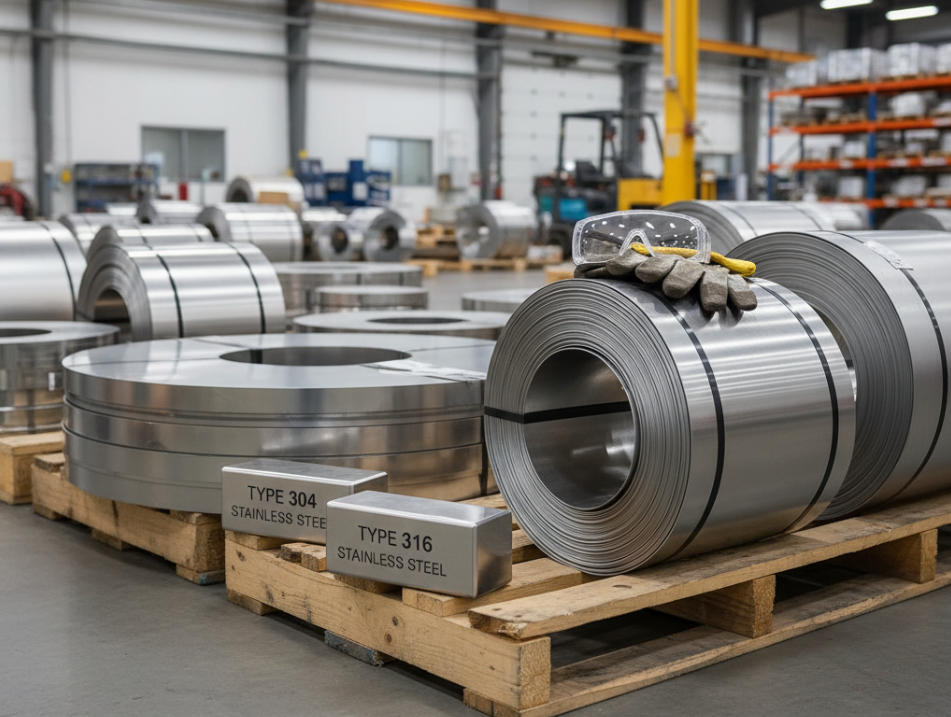
The global trend is shifting from single-layer stainless steel to tri-ply and five-ply composite bottoms. This change improves heat distribution and makes cookware compatible with induction cooktops. High-end markets in Europe, America, and Japan especially value 316-grade steel and composite bottoms.
When I started INOXICON in 1997, most customers wanted basic 201 stainless steel. Today, 70% of our exports use 304 or 316 stainless steel with aluminum cores. The cost difference is significant - tri-ply cookware costs 40-60% more than single-layer, but commands premium prices in developed markets.
Ask your potential manufacturer for their material cost breakdown. A 304 stainless steel pot with aluminum bottom typically costs $2-3 more than basic 201 steel, but sells for $8-12 more in retail. This helps you make informed decisions based on your target market positioning.
How do you ensure food-grade safety and compliance with LFGB, FDA, or REACH standards?
Food safety regulations are getting stricter every year. A manufacturer without proper compliance systems will put your business at risk with regulatory authorities.
More importing countries are strengthening PFAS restrictions. This will become a major export barrier in the next 2-3 years for non-compliant manufacturers.
PFAS (forever chemicals) restrictions are the new frontier in cookware regulation. These substances don't break down naturally and accumulate in the environment. The European Union is leading the charge, with the US following closely behind.
I've invested heavily in PFAS-free coating solutions over the past three years. We now offer ceramic coatings and powder-based non-stick alternatives that meet the strictest international standards. Many smaller manufacturers still rely on traditional PFOA-free coatings, which may not satisfy future PFAS requirements.
Ask your manufacturer about their PFAS-free coating options and testing capabilities. Request recent test reports from accredited laboratories. A manufacturer who can provide SGS or Intertek reports for LFGB, FDA, and REACH compliance demonstrates serious commitment to quality. Also inquire about their coating adhesion standards - proper adhesion prevents coating flakes from contaminating food.
Do you have internal laboratories for coating adhesion and salt-spray tests?
About 60% of OEM manufacturers rely on external third-party testing, which slows down sample validation and product development. Internal laboratories indicate serious quality commitment.
Manufacturers with in-house testing capabilities can perform coating adhesion, hardness, and thermal shock tests immediately, reducing sample development time by 50-70%.

At INOXICON, we built our own testing laboratory in 2018 after experiencing delays with external testing labs. Our lab can perform coating adhesion tests, salt spray corrosion tests, thermal shock resistance, and hardness measurements within 24-48 hours instead of waiting 7-10 days for external results.
Internal testing capabilities also indicate a manufacturer's technical depth. They understand what affects product performance and can optimize formulations quickly. When we develop new non-stick coatings, we can test dozens of variations per week instead of per month.
Ask potential manufacturers about their specific testing equipment. Key tests include: coating adhesion (cross-cut test), salt spray resistance (minimum 48 hours), thermal shock (rapid temperature changes), and surface hardness measurements. A manufacturer who can explain these tests in detail likely has the equipment and expertise to ensure consistent quality.
How do you manage raw-material price fluctuations for stainless steel and aluminum?
Stainless steel and aluminum prices can fluctuate 20-30% annually. Manufacturers without price management strategies will pass volatility directly to you or compromise on quality.
Manufacturers with annual raw material contracts or price-locking agreements offer more stable pricing and reduced supply chain risks for long-term partnerships.
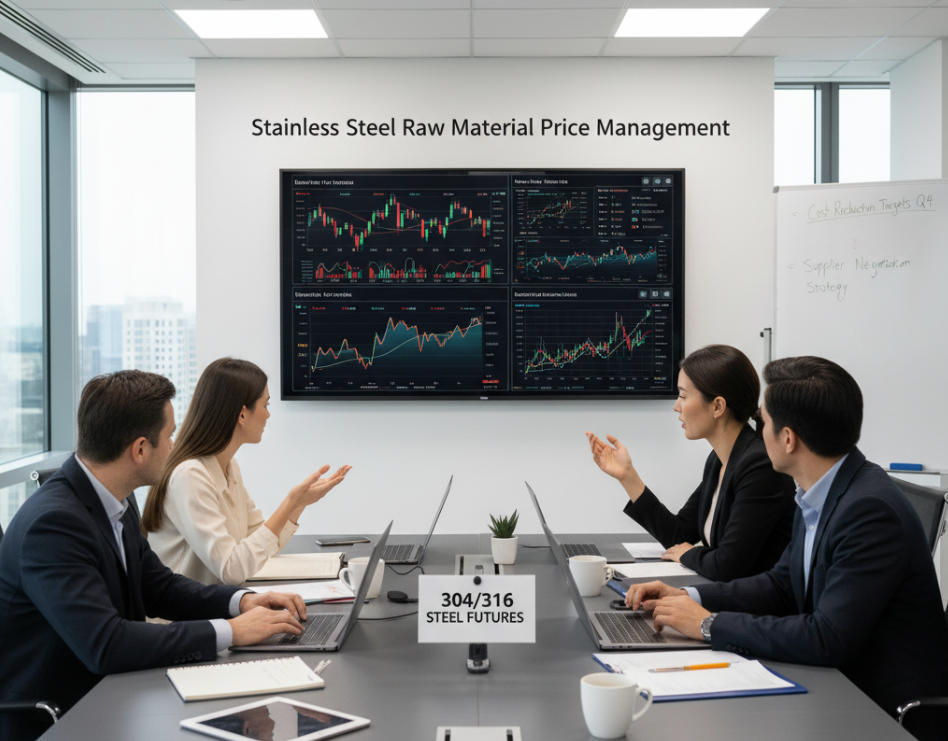
Raw material costs represent 60-70% of cookware manufacturing expenses. In 2023, we experienced steel price increases of 25% within six months due to global supply chain disruptions. Manufacturers who buy materials spot market-style face constant price pressure.
INOXICON maintains annual contracts with three major steel suppliers, securing 80% of our material needs at fixed prices. This strategy protects both our costs and our customers' budgets. When steel prices spike unexpectedly, we can maintain agreed pricing for existing orders and provide more accurate quotes for new projects.
Ask manufacturers how they handle material price fluctuations. Do they have forward contracts? How much inventory do they maintain? What's their policy when raw material costs increase mid-production? Manufacturers with sophisticated purchasing systems demonstrate better business stability and can offer more predictable pricing for your import business.
What level of automation does your production line achieve?
Manual production processes result in 3-5% defect rates and inconsistent quality. Automated lines reduce defects to under 1% while improving delivery speed by 15-20%.
Automated stamping, welding, and polishing lines ensure consistent quality and faster production times, crucial for large-volume orders and tight delivery schedules.
We've invested $2.8 million in automated equipment over the past five years. Our automated stamping lines can produce 1,200 pieces per hour with dimensional accuracy within 0.1mm. Manual stamping typically achieves 300-400 pieces per hour with 0.3-0.5mm variations.
Automation particularly benefits complex products like multi-layer cookware bottoms. Our automated welding system ensures perfect aluminum-steel bonding without air gaps or weak spots. Manual welding creates inconsistencies that affect heat distribution and durability.
Request factory videos or virtual tours focusing on their production equipment. Look for automated feeding systems, robotic welding arms, and computerized polishing machines. Ask about their daily production capacity and quality control checkpoints. A manufacturer producing 30,000+ pieces daily likely has significant automation, while those claiming similar output with mostly manual processes may struggle with consistency and lead times.
Can you handle small-batch or quick-response orders for D2C brands?
Direct-to-consumer kitchen brands are growing rapidly and need flexible manufacturers who can handle MOQs under 500 sets with delivery times under 30 days.
D2C brands require quick-response manufacturing capabilities and flexible minimum order quantities to test new products and respond rapidly to market trends.
The D2C cookware market is exploding, driven by social media marketing and e-commerce platforms. These brands need to test products quickly, launch seasonal variations, and respond to trending designs within weeks, not months.
We've developed a flexible production system specifically for small-batch orders. By sharing tooling costs across multiple customers and maintaining quick-change capabilities on our production lines, we can deliver 500-piece orders in 25-30 days instead of the traditional 45-60 days.
Our "shared mold program" allows D2C brands to access professional-grade tooling at 60% lower costs. Instead of paying $3,000-5,000 for exclusive molds, they pay $1,200-2,000 for shared access with size and color customization options.
Ask manufacturers about their small-batch capabilities, shared tooling programs, and quick-response production schedules. Can they handle rush orders? Do they maintain inventory of common components? How do they manage small orders without compromising larger customers' schedules?
What are your sustainability initiatives — recycled steel, eco coating, or green packaging?
European importers increasingly require Life Cycle Assessment reports and recyclable packaging. Manufacturers without sustainability programs limit your market access.
Sustainable cookware markets are growing at 8%+ annually. Manufacturers with ESG reporting capabilities and eco-friendly materials offer competitive advantages in premium markets.
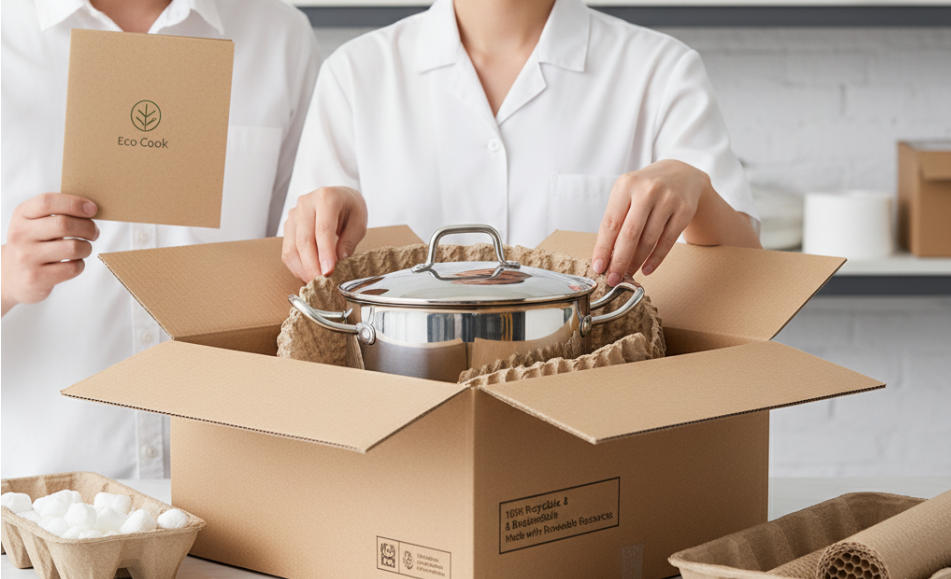
Sustainability isn't just about marketing anymore - it's becoming a regulatory requirement. The European Union's Green Deal affects cookware imports through packaging regulations, material sourcing requirements, and carbon footprint reporting.
INOXICON achieved 35% recycled steel content in our stainless steel cookware by partnering with certified steel recyclers. We've also eliminated plastic packaging for 80% of our product lines, replacing it with recyclable cardboard and biodegradable protective materials.
Our sustainability initiatives include energy-efficient production (30% reduction in power consumption per piece), water recycling systems (40% reduction in water usage), and waste heat recovery from our polishing operations. These improvements reduce our environmental impact while lowering production costs.
Ask manufacturers about their recycled material content, energy efficiency measures, and packaging sustainability. Request their ESG reports or environmental certifications. Manufacturers serious about sustainability can provide specific metrics and improvement targets, not just general claims about being "eco-friendly."
How do you control defect rate and after-sales service for export orders?
Top-tier export manufacturers maintain defect rates below 0.5% and provide clear policies for handling quality issues including rework options and credit systems.
Quality control systems and after-sales service policies directly impact your customer satisfaction and return rates in international markets.
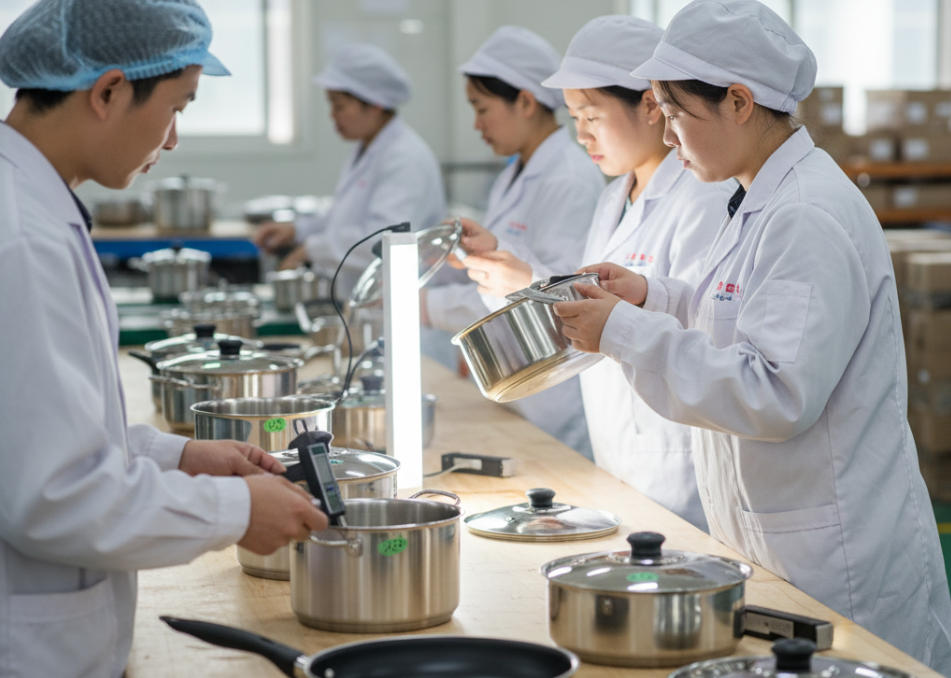
Quality control is where many manufacturers cut corners to reduce costs. At INOXICON, we maintain seven inspection checkpoints throughout production: raw material inspection, stamping dimensional checks, welding quality verification, coating adhesion testing, final assembly inspection, packaging verification, and pre-shipment audits.
Our defect rate averages 0.3% for export orders, achieved through systematic quality control and continuous improvement. When defects occur, we provide three resolution options: full replacement at our cost, partial credit toward future orders, or rework service if time permits.
We track quality metrics by customer, product type, and production period. This data helps identify trends and prevent recurring issues. For example, we discovered that coating defects increased during high-humidity periods, leading us to invest in climate-controlled coating booths.
Ask manufacturers about their specific quality control procedures, defect rate targets, and after-sales policies. How many inspection points do they maintain? What's their historical defect rate? How do they handle quality issues discovered after shipment? Manufacturers with detailed answers demonstrate systematic quality management.
Do you provide ODM design support — 3D rendering, mock-ups, and packaging concepts?
High-end manufacturers increasingly offer ODM services, providing structural optimization, brand color schemes, and packaging design during product development phases.
ODM capabilities help brands launch differentiated products faster while reducing development costs and technical risks through manufacturer expertise.
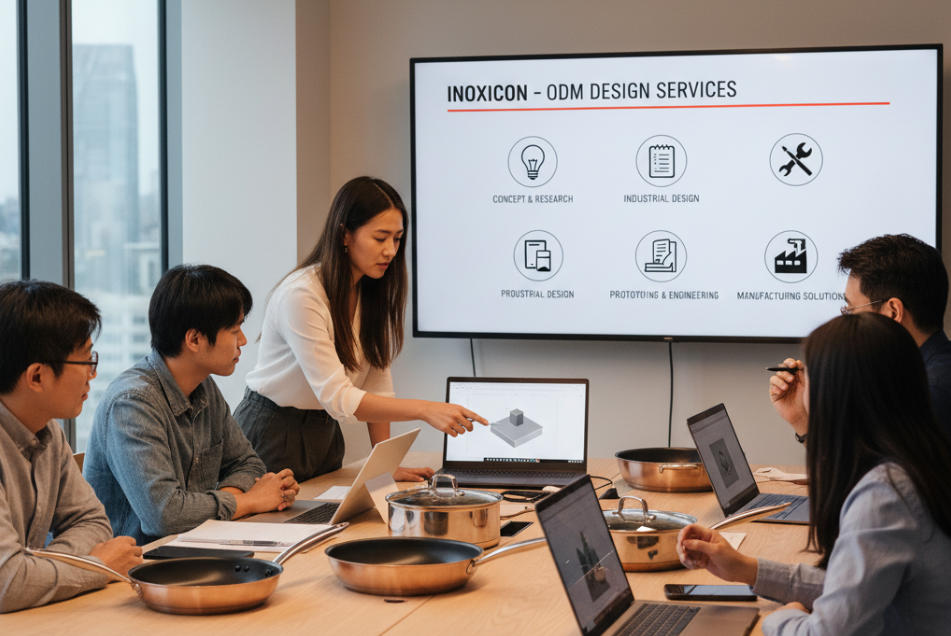
Original Design Manufacturing (ODM) services transform manufacturers from simple production vendors into strategic partners. Our five-person design team, with an average of 15 years' experience, develops over 50 new products annually for customers worldwide.
ODM services include product concept development, 3D rendering and prototyping, structural engineering optimization, color and finish selection, packaging design, and user manual creation. We've helped customers launch successful product lines by combining market trends with manufacturing feasibility.
For example, we developed a modular cookware system for a European client, allowing customers to purchase individual pieces or complete sets with interlocking storage. This design increased their average order value by 40% while reducing packaging costs through efficient nesting.
Our ODM process typically takes 45-60 days from concept to final prototype, including two revision rounds and functional testing. We provide detailed technical drawings, material specifications, and manufacturing cost analysis to help customers make informed decisions.
Ask manufacturers about their design team size, ODM project experience, and development timelines. Can they show examples of successful ODM projects? Do they understand your target market's preferences and regulatory requirements?
What are your lead time guarantees and peak-season capacity plans?
Peak season exports (September-December) typically increase 40%, creating delivery risks. Manufacturers need capacity management plans and backup strategies for on-time delivery.
Lead time reliability during peak seasons determines whether you can fulfill customer orders during the most critical selling period of the year.
Peak season capacity management separates professional manufacturers from small-scale operators. During Q4 2023, we handled 45% more orders than Q2 while maintaining average lead times of 32 days versus our standard 28 days - only a 14% increase despite much higher volume.
Our capacity management includes workforce planning (we hire 35% more temporary workers for peak season), equipment scheduling optimization, raw material pre-purchasing, and partnerships with two backup manufacturers for overflow production. We also prioritize coating line capacity, which typically becomes the bottleneck during high-volume periods.
We provide customers with quarterly capacity forecasts and recommend order timing to avoid peak season delays. Customers who place orders by August typically receive better scheduling and pricing than those waiting until September or October.
INOXICON guarantees delivery within 5 days of promised dates or provides 2% price credits for delays. This guarantee is possible because of our systematic capacity planning and backup production arrangements.
Ask manufacturers about their peak season capacity increases, workforce scaling plans, and delivery guarantee policies. Do they have backup production partners? How do they prioritize orders during high-demand periods? What's their on-time delivery rate during peak seasons versus regular periods?
Conclusion
These ten questions will help you identify professional cookware manufacturers who can support your long-term business growth with consistent quality, reliable delivery, and competitive pricing.